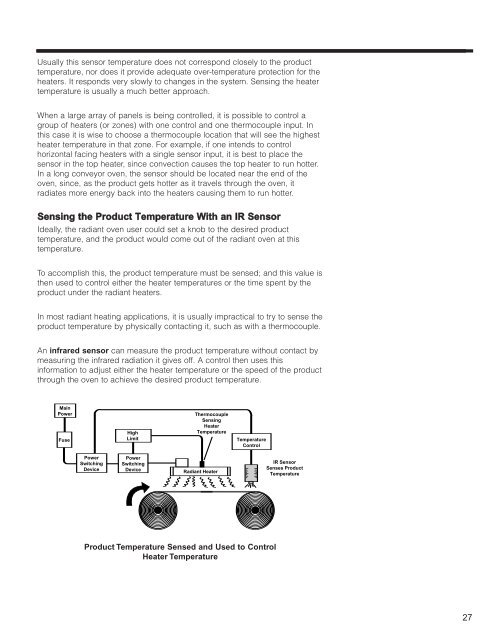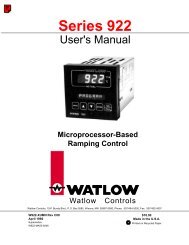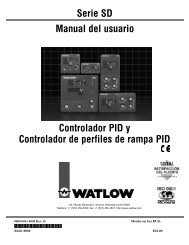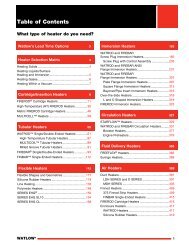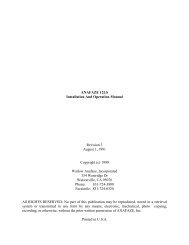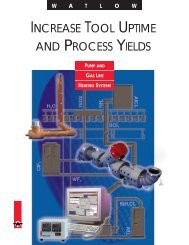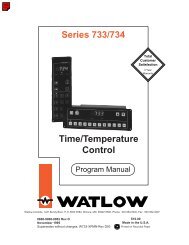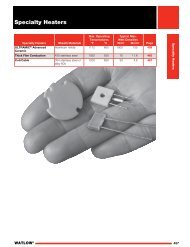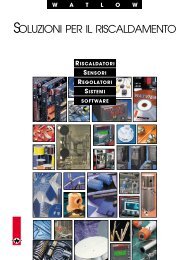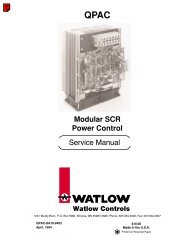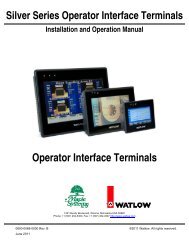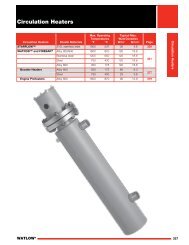RADIANT HEATING WITH INFRARED - Watlow
RADIANT HEATING WITH INFRARED - Watlow
RADIANT HEATING WITH INFRARED - Watlow
You also want an ePaper? Increase the reach of your titles
YUMPU automatically turns print PDFs into web optimized ePapers that Google loves.
Usually this sensor temperature does not correspond closely to the product<br />
temperature, nor does it provide adequate over-temperature protection for the<br />
heaters. It responds very slowly to changes in the system. Sensing the heater<br />
temperature is usually a much better approach.<br />
When a large array of panels is being controlled, it is possible to control a<br />
group of heaters (or zones) with one control and one thermocouple input. In<br />
this case it is wise to choose a thermocouple location that will see the highest<br />
heater temperature in that zone. For example, if one intends to control<br />
horizontal facing heaters with a single sensor input, it is best to place the<br />
sensor in the top heater, since convection causes the top heater to run hotter.<br />
In a long conveyor oven, the sensor should be located near the end of the<br />
oven, since, as the product gets hotter as it travels through the oven, it<br />
radiates more energy back into the heaters causing them to run hotter.<br />
Sensing the Product Temperature With an IR Sensor<br />
Ideally, the radiant oven user could set a knob to the desired product<br />
temperature, and the product would come out of the radiant oven at this<br />
temperature.<br />
To accomplish this, the product temperature must be sensed; and this value is<br />
then used to control either the heater temperatures or the time spent by the<br />
product under the radiant heaters.<br />
In most radiant heating applications, it is usually impractical to try to sense the<br />
product temperature by physically contacting it, such as with a thermocouple.<br />
An infrared sensor can measure the product temperature without contact by<br />
measuring the infrared radiation it gives off. A control then uses this<br />
information to adjust either the heater temperature or the speed of the product<br />
through the oven to achieve the desired product temperature.<br />
Main<br />
Power<br />
Fuse<br />
Power<br />
Switching<br />
Device<br />
High<br />
Limit<br />
Power<br />
Switching<br />
Device<br />
Thermocouple<br />
Sensing<br />
Heater<br />
Temperature<br />
Radiant Heater<br />
Temperature<br />
Control<br />
Product Temperature Sensed and Used to Control Heater Temperature<br />
Product Temperature Sensed and Used to Control<br />
Heater Temperature<br />
IR Sensor<br />
Senses Product<br />
Temperature<br />
27


